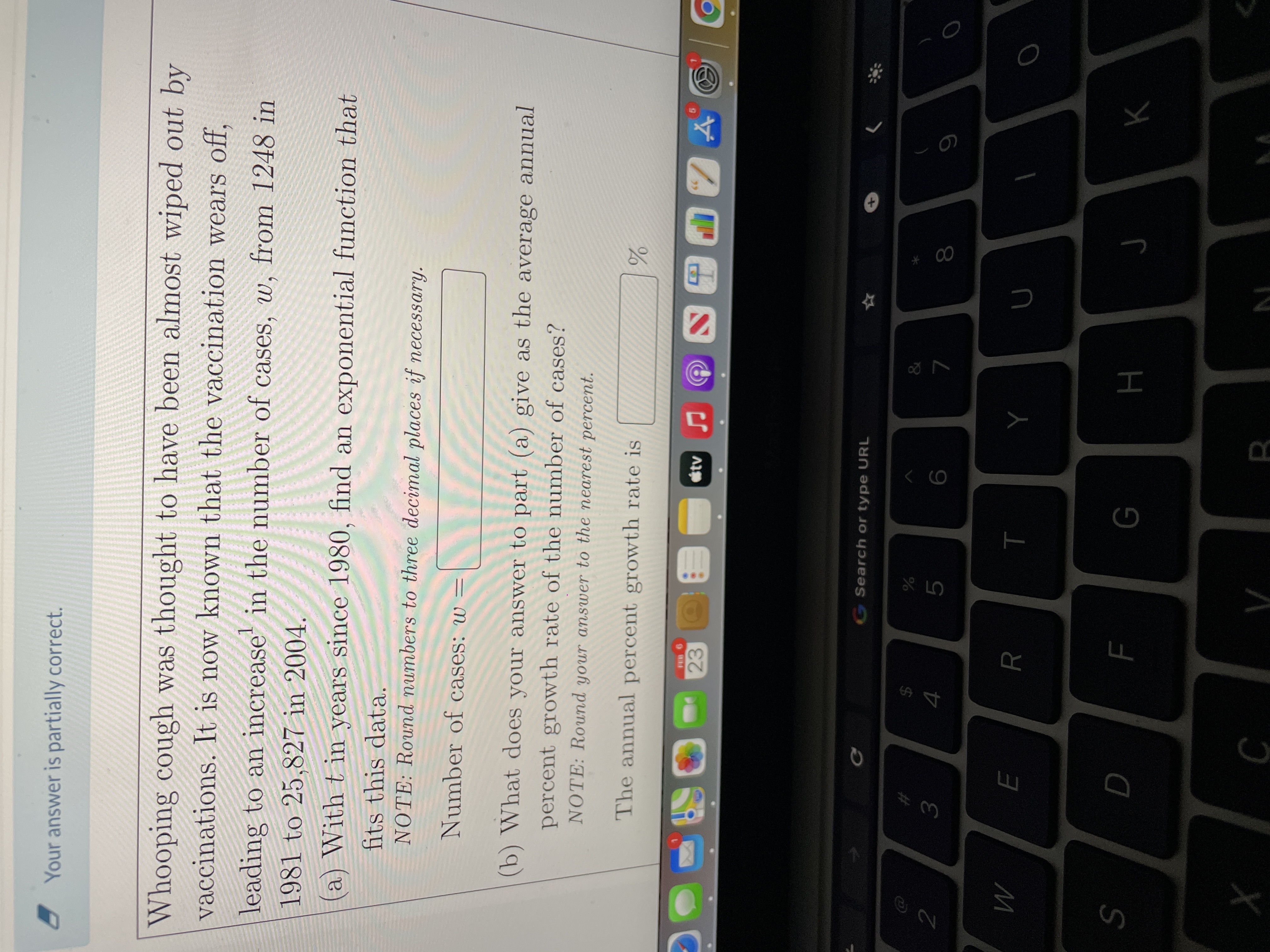
Calculus: Early Transcendentals
8th Edition
ISBN: 9781285741550
Author: James Stewart
Publisher: Cengage Learning
expand_more
expand_more
format_list_bulleted
Question

Transcribed Image Text:* 00
Your answer is partially correct.
Whooping cough was thought to have been almost wiped out by
vaccinations. It is now known that the vaccination wears off,
leading to an increase' in the number of cases, w, from 1248 in
1981 to 25,827 in 2004.
(a) With t in years since 1980, find an exponential function that
fits this data.
NOTE: Round numbers to three decimal places if necessary.
Number of cases: w =
(b) What does your answer to part (a) give as the average annual
percent growth rate of the number of cases?
NOTE: Round your answer to the nearest percent.
The annual percent growth rate is
23
G Search or type URL
%24
2
3.
5.
7.
6
R
Expert Solution
This question has been solved!
Explore an expertly crafted, step-by-step solution for a thorough understanding of key concepts.
This is a popular solution
Trending nowThis is a popular solution!
Step by stepSolved in 2 steps with 1 images

Knowledge Booster
Similar questions
- The following table relates the weight of garbage in tons to the time in years since 1984. It is known that the relationship is exponential. Use the table to answer the following questions. Number of years since 1984 1 3 5 7 9 Weight of garbage (in tons) 2580 3715.2 5349.888 7703.83872 11093.52776 What is the 2-year growth factor? What is the 1-year percent change? What was the weight of the garbage in 1982?arrow_forwardWhich of the following display exponential growth? Select all that apply. OP = 750(0.995)* OP = 5,000() Population Year Size 2003 1,250 2004 1,375 2005 1,513 2006 1,665 2007 1,832 Number of Population Years Size 850 1 955 2 1,060 3 1,165 4 1,270 Time Population sizearrow_forwardA 1987 treaty to protect the ozone (0, 1046) 1100, 1000 layer produced dramatic declines in global production, P, of chlorofluorocarbons (CFCS). 900 800 700 600 (5, 338) 500 400 See figure to the right." 300 Find a formula for P as an 200 100 exponential function of the number 10 15 of years, t, since 1989. Years since 1989 What was the annual percent decay rate? NOTE: Round the numbers in the formula to three decimal places if needed. P(t) -0.226t 1046 e CFC production was decreasing at a rate of % per year during this time period. P (thousand tons)arrow_forward
arrow_back_ios
arrow_forward_ios
Recommended textbooks for you
 Calculus: Early TranscendentalsCalculusISBN:9781285741550Author:James StewartPublisher:Cengage Learning
Calculus: Early TranscendentalsCalculusISBN:9781285741550Author:James StewartPublisher:Cengage Learning Thomas' Calculus (14th Edition)CalculusISBN:9780134438986Author:Joel R. Hass, Christopher E. Heil, Maurice D. WeirPublisher:PEARSON
Thomas' Calculus (14th Edition)CalculusISBN:9780134438986Author:Joel R. Hass, Christopher E. Heil, Maurice D. WeirPublisher:PEARSON Calculus: Early Transcendentals (3rd Edition)CalculusISBN:9780134763644Author:William L. Briggs, Lyle Cochran, Bernard Gillett, Eric SchulzPublisher:PEARSON
Calculus: Early Transcendentals (3rd Edition)CalculusISBN:9780134763644Author:William L. Briggs, Lyle Cochran, Bernard Gillett, Eric SchulzPublisher:PEARSON Calculus: Early TranscendentalsCalculusISBN:9781319050740Author:Jon Rogawski, Colin Adams, Robert FranzosaPublisher:W. H. Freeman
Calculus: Early TranscendentalsCalculusISBN:9781319050740Author:Jon Rogawski, Colin Adams, Robert FranzosaPublisher:W. H. Freeman
 Calculus: Early Transcendental FunctionsCalculusISBN:9781337552516Author:Ron Larson, Bruce H. EdwardsPublisher:Cengage Learning
Calculus: Early Transcendental FunctionsCalculusISBN:9781337552516Author:Ron Larson, Bruce H. EdwardsPublisher:Cengage Learning

Calculus: Early Transcendentals
Calculus
ISBN:9781285741550
Author:James Stewart
Publisher:Cengage Learning

Thomas' Calculus (14th Edition)
Calculus
ISBN:9780134438986
Author:Joel R. Hass, Christopher E. Heil, Maurice D. Weir
Publisher:PEARSON

Calculus: Early Transcendentals (3rd Edition)
Calculus
ISBN:9780134763644
Author:William L. Briggs, Lyle Cochran, Bernard Gillett, Eric Schulz
Publisher:PEARSON

Calculus: Early Transcendentals
Calculus
ISBN:9781319050740
Author:Jon Rogawski, Colin Adams, Robert Franzosa
Publisher:W. H. Freeman


Calculus: Early Transcendental Functions
Calculus
ISBN:9781337552516
Author:Ron Larson, Bruce H. Edwards
Publisher:Cengage Learning